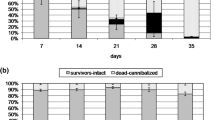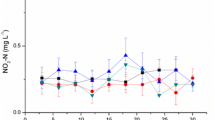Abstract
A choice feeding test using 21 amino acids was conducted to determine the feeding preference of Formosan subterranean termite,Coptotermes formosanus Shiraki, in the laboratory. Significantly more filter paper treated withd-aspartic acid orl-glutamic acid was consumed by Formosan subterranean termites than was control filter paper treated with water. In two-choice feeding tests, termites consumed significantly more filter paper treated withd-aspartic acid orl-aspartic acid than paper treated with water. Addingl-proline,l-lysine, orl-isoleucine to filter paper significantly increased consumption compared with control filter paper in no-choice tests. The use of amino acid additives in termite baits is briefly discussed.
Similar content being viewed by others
References
Allsopp, P. G. 1992. Sugars, amino acids, and ascorbic acid as phagostimulants for larvae ofAntitrogus parvulus andLepidiota negatoria (Coleoptera: Scarabaeidae).J. Econ. Entomol. 85:106–111.
Bess, H. A. 1970. Termites of Hawaii and the oceanic islands, pp. 449–472,in K. Krishna and F. M. Weesner (eds.). Biology of Termites, Vol. 2. Academic Press, New York.
Brooks, M. A. 1963. The microorganisms of healthy insects, pp. 215–250,in E. A. Steinhaus (ed.). Insect Pathology. Academic Press, New York.
Chen, J. C. P. 1985. Bagasse and its uses, pp. 106–126,in J. C. P. Chen (ed.). Cane Sugar Handbook, 11th ed. John Wiley & Sons, New York.
Cowling, E. B., andMerrill, W. 1966. Nitrogen in wood and its role in wood deterioration.Can. J. Bot. 44:1539–1554.
Dai, Z.-R. andLuo, J.-Z. 1980. Preliminary observation on feeding of Formosan subterranean termites.Kun Chong Zhi Shi 17:74–76 (in Chinese).
Esenther, G. R., andBeal, R. H. 1979. Termite control: Decayed wood bait.Sociobiology 4:215–222.
Esenther, G. R., andGray, D. E. 1968. Subterranean termite studies in southern Ontario.Can. Entomol. 100:827–834.
French, J. R. J., andRobinson, P. J. 1981. Baits for aggregating large numbers of subterranean termites.J. Aust. Entomol. Soc. 20:75–76.
French, J. R. J., Robinson, P. J., andEwart, D. M. 1986. Mound colonies ofCoptotermes lacteus (Isoptera) eat cork in preference to sound wood.Sociobiology 11:303–309.
Haverty, M. I., Nutting, W. L., andLa Fage, J. P. 1975. Density of colonies and spatial distribution of foraging territories of the desert subterranean termites,Heterotermes aureus (Snyder).Environ. Entomol. 4:105–109.
Haverty, M. I., Su, N. Y., Tamashiro, M., andYamamoto, R. T. 1989. Concentration-dependent presoldier induction and feeding deterrency: Potential of two insect growth regulators for remedial control of the Formosan subterranean termite (Isoptera: Rhinotermitidae).J. Econ. Entomol. 82:1370–1374.
Hungate, R. E. 1941. Experiments on the nitrogen economy of termites.Ann. Entomol. Soc. Am. 34:467–489.
Irvine, J. E. 1985. Sugarcane and sugar, part (B), Sugars and nonsugars, pp. 18–43,in J. C. P. Chen (ed.). Cane Sugar Handbook, 11th ed. John Wiley & Sons, New York.
Jones, S. C. 1984. Evaluation of two insect growth regulators for the bait-block method of subterranean termite (Isoptera: Rhinotermitidae) control.J. Econ. Entomol. 77:1086–1091.
La Fage, J. P., Su, N.-Y., Jones, M. J., andEsenther G. R. 1983. A rapid method for collecting large number of subterranean termites from wood.Sociobiology 7:305–309.
Lai, P. Y., Tamashiro, M., Yates, J. R., Su, N.-Y., Fujii, J. K., andEbesu, R. H. 1983. Living plants in Hawaii attacked byCoptotermes formosanus.Proc. Hawaii. Entomol. Soc. 24:283–286.
Li, G.-X., Dai, Z.-R., andYang, B. 1994. Introduction to termite research in China.J. Appl. Entomol. 117:360–369.
Meehan, M., andWilde, G. 1989. Screening for sorghum line and hybrid resistance to chinch bug (Hemiptera: Lygaeidae) in the greenhouse and growth chamber.J. Econ. Entomol. 82:616–620.
Mishra, S. C. 1992. Attraction and acceptance responses of termiteNeotermes bosei Snyder (Kalotermitidae) to organic compounds and solvents.Indian J. For. 15:245–249.
Potrikus, C. J., andBreznak, J. A. 1977. Nitrogen-fixingEnterobacter agglomerans isolated from guts of wood-eating termites.Appl. Microbiol. 33:392–399.
Sas Institute. 1988. SAS Institute Inc., Cary, NC.
Scriber, J. M. 1979. Post-ingestive utilization of plant biomass and nitrogen by Lepidoptera: Legume feeding by the southern armyworm.J. N.Y. Entomol. Soc. 87:141–153.
Shellman-Reeve, J. S. 1990. Dynamics of biparental care in the dampwood termite,Zootermopsis nevadensis (Hagen): response to nitrogen availability.Behav. Ecol. Sociobiol. 26:389–397.
Slansky, F., Jr., andFeeny, P. 1977. Stabilization of the rate of nitrogen accumulation by larvae of the cabbage butterfly on wild and cultivated food plants.Ecol. Monogr. 47:209–228.
Spears, B. M., andUeckert, D. N. 1976. Survival and food consumption by the desert termiteGnathamitermes tubiformans in relation to dietary nitrogen source and levels.Environ. Entomol. 5:1022–1025.
Spink, W. T. 1967. The Formosan subterranean termite in Louisiana. Agricultural Experiment Station Circular No. 89. Louisiana State University Agricultural Center, Baton Rouge, Louisiana, 12 pp.
Su, N.-Y. 1994. Field evaluation of hexaflumoron bait for population suppression of subterranean termites (Isoptera: Rhinotermitidae).J. Econ. Entomol. 87:389–397.
Su, N.-Y., Ban, P. M., andScheffrahn, R. H. 1991a. Population suppression of field colonies of the Formosan subterranean termite (Isoptera: Rhinotermitidae) by dihaloalkyl arylsulfone (A-9248) baits.J. Econ. Entomol. 84:1525–1531.
Su, N.-Y., Scheffrahn, R. H., andBan, P. M. 1991b. Uniform size particle barrier: A physical exclusion device against subterranean termites (Isoptera: Rhinotermitidae).J. Econ. Entomol. 84:912–916.
Tamashiro, M., Yates, J. R., Yamamoto, R. T., andEbesu, R. H. 1991. Tunneling behavior of the Formosan subterranean termite and basalt barriers.Sociobiology 19:163–170.
Yaga, S. 1972. On the secretion of termites,Coptotermes formosanus Shiraki.Sci. Bull. Coll. Agric. Univ. Ryukyus 19:481–488.
Zhao, Y. 1981. Bait efficacy of Formosan subterranean termite.Shang Pin Bao Hu Ji Shu 2:1–5 (in Chinese).
Author information
Authors and Affiliations
Rights and permissions
About this article
Cite this article
Chen, J., Henderson, G. Determination of feeding preference of Formosan subterranean termite (Coptotermes formosanus Shiraki) for some amino acid additives. J Chem Ecol 22, 2359–2369 (1996). https://doi.org/10.1007/BF02029552
Received:
Accepted:
Issue Date:
DOI: https://doi.org/10.1007/BF02029552




